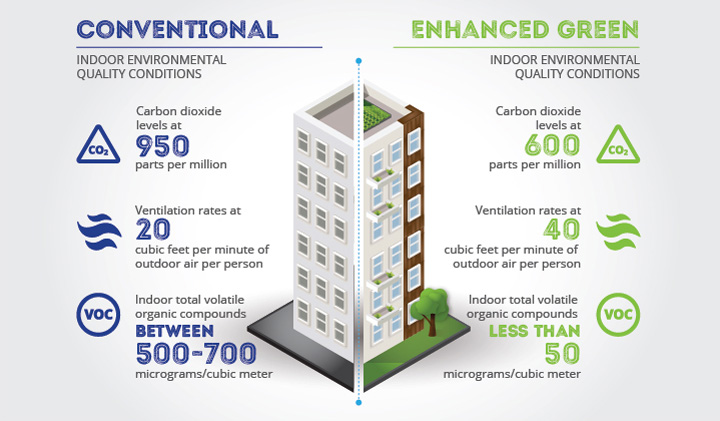 |
| |
| Study Highlights |
| Harvard’s New Global Study Finds Green Buildings Provide Nearly US$6 Billion in Benefits to Health and Climate |
| Did you know buildings can deliver billions of dollars’ worth of public health benefits, including fewer hospitalizations and reduced climate impacts? A new study says that’s the case – if they’re energy-efficient buildings. |
New research out from the Harvard T.H. Chan School of Public Health suggests the value proposition for green buildings is nearly double what was previously thought – in some places as much as 12 times as great.
Known as HEALTHfx, the study examined a subset of green-certified buildings over a 16-year period in six countries: the U.S., China, India, Brazil, Germany and Turkey, they found nearly US$6 billion in combined health and climate benefits which equate to:
US$4.4 billion in estimated public health benefits from fewer:
|
 |
Deaths |
 |
Hospital visits |
 |
Asthma attacks |
 |
Respiratory symptoms |
 |
Lost days of work |
 |
Lost days of school |
US$1.4 billion in estimated climate benefits from reductions in:
|
 |
Carbon dioxide |
 |
Methane |
 |
Nitrous oxide |
For example, in China, the research finds that at the country level, for every US$1 saved on energy, another US$8.89 is saved in health and climate benefits. At building level, there is a total saving of US$6.50 per square meter combined from the energy and health and climate costs saving. |
 |
Besides public health and climate benefits, green buildings also impact cognitive function of occupants. The journey started in 2015 when the same team has conducted the COGfx Study – COGfx is shorthand for your brain’s cognitive function – which showed 101% improvement in cognitive function test scores when workers spent time in an office with high ventilation, low CO2 and low volatile organic compounds, compared to when they were in a “conventional” office environment. In 2016, the team expanded the experiment and found that, in green-certified buildings, employees scored 26% higher on cognitive function tests, reported 30% fewer sick building symptoms and 6% higher sleep quality scores.
When researchers looked at the effect of CO2 — not normally thought of as a direct indoor pollutant — they found that it seemed to have a major effect. “Cognitive function scores were 15% lower for the moderate CO2 day (~945 ppm) and 50% lower on the day with CO2 concentrations around 1,400 ppm than on the two Green+ days,” the researchers wrote. |
 |
Below is a breakdown of the cognitive function test scores of the 24 study participants. The largest improvements in cognitive function occurred with crisis response, information usage and strategy.
|
As the one who operates or owns the buildings, what do these mean to you?
Now, consider the fact that most of us spend about 90% of our time indoors and 90% of the costs associated with a building are due to the people inside it – and you can see why focusing on the air you breathe could enjoy health co-benefits of green buildings and turn your building into your business’ strongest resource tool. As it turns out, intelligence really is in the air.
To fill key knowledge gaps in this important area, linking indoor environment with decision making, visit here for the full reports of HEALTHfx and COGfx studies: |
| |
 |
Feel free to share this newsletter with other building owners or
operators you know who may like to be part of our conversations. |
|
Click here to sign up for the "Engineering Upgrade for Large Buildings" Program if you haven't
Want to change how you receive these emails? You can unsubscribe from this list.
Copyright © United Technologies. All rights reserved. |
|
|
|
|
